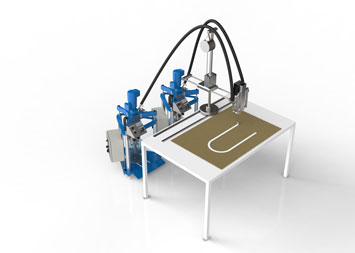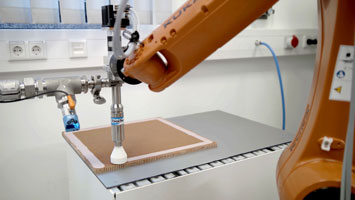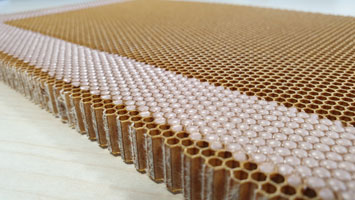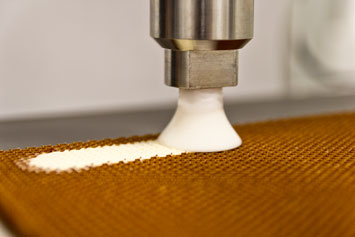Honeycomb Potting
Automated filling of honeycomb structures for aircraft interiors
Profitability is also the top priority in the aviation industry. To get aircraft from A to B economically, they have to be as light as possible, meaning that they consume less fuel. The airlines save money and at the same time the environmental impact is reduced.
Despite their low weight, components in aircraft have to meet high safety and stability requirements. And lightweight often means thin and not stable. And this is where lightweight construction and honeycomb potting come into play. Honeycomb panels” or “sandwich panels with a honeycomb core” are used in aircraft cabins. They are indispensable for interior fittings, for example. They are used in the side walls, partition walls, baggage compartments and floors, but also in the exterior of turbines.
The panels are lightweight structures that are not heavy but still flexible in their original state. For structural reinforcement or to obtain stable joints, the honeycombs are filled with core fillers. Strict requirements apply to these so-called “core fillers,” especially with regard to fire protection. And they must of course be as light as possible. The pastes have a low density and contain microfine fillers, such as hollow glass spheres, to reduce weight. For dispensing the challenging core fillers, dispensing pumps based on the endless piston principle, such as those in ViscoTec’s portfolio, have proven their worth. These pumps process fluids and pastes particularly gently and with low shear.
Only when the panels are filled can they be processed further without damage, e.g. cut to size. Only then do they exhibit the required properties. When filling the honeycombs, a distinction is made between honeycomb potting and insert potting. In insert potting, the honeycombs are filled only selectively – for the subsequent fastening of components. In addition, the adhesive used differs from the materials used for honeycomb potting.
You are currently viewing a placeholder content from YouTube. To access the actual content, click the button below. Please note that doing so will share data with third-party providers.
More InformationProblems with manual processing of core fillers
Up until now, the filling of honeycomb panels has mainly been carried out manually. This leads to increased labor and material costs: In the case of 2-component materials, both components must be mixed together. The operator weighs out one part of each component according to the specified mixing ratio and then kneads the two components together like a dough, until an optically homogeneous mixture is obtained. On the one hand, this is very time-consuming. On the other hand, it is not possible to obtain a consistent mixing quality in this way. This can differ from one operator to the next.
When it comes to filling the honeycombs, the operator places a template on the honeycomb panel and fills the open areas. To do this, he presses the material, which was previously taken manually from the delivery container, into the honeycomb cores. Alternatively, he tapes off the areas that are not to be filled.
Both processes, the mixing of the material and the filling of the honeycombs, are therefore very time-consuming. And another, not insignificant aspect: In both cases, the operator is in direct contact with the materials, some of which are harmful to their health!
There are various quality requirements for filling: The combs must be completely filled. There must be no honeycomb bursts. And only a defined area should be filled. The source of errors in manual masking with adhesive tape must not be underestimated. It is quick to apply too little or too much tape. In general, the quality is extremely dependent on the operators and is not consistent. And: Customers sometimes require large quantities, since honeycombs are used in a wide variety of areas in the aircraft and in large numbers, as already described. This requires a great deal of manpower.
Automated honeycomb potting for optimized processes
The remedy is automated filling of the panels with specially developed dispensing systems and filling nozzles connected to a robot or gantry system. With automated filling, the result is more uniform, the honeycombs are filled perfectly and cleanly. And a great deal of material is saved compared to manual application.
Essentially, three different components for an automated honeycomb potting process are needed:
1. Dispensing equipment:
Depending on the material to be dispensed, a 1- or 2-component dispenser must be selected. For 2-component materials, it is important that the dispenser can handle extreme mixing ratios. In addition, depending on the container size, different dispensing systems are also required. The following applies to both dispensers and removal systems: Gentle material handling due to the hollow spheres, as filler in the core fillers, is an absolute prerequisite. In addition, both systems must be suitable for highly viscous materials.
2. Handling system:
A distinction must be made here as to whether the process is semi-automatic or fully automatic. Semi-automatic processes can be completely covered by dispensing technology specialists such as ViscoTec. For fully automatic processes, good cooperation between the dispensing technology manufacturer and an integrator is extremely important.
– Semi-automatic system: The dispenser for applying the core filler is attached to a handling system that is guided by hand. This results in numerous advantages: The operator’s job is made much easier; there is no longer any direct material contact; and the filling of the honeycombs can take place much faster. With 2-component materials, the dispensing system takes over the mixing of the components. The result is a repeatable and precise mixing of the material. This precise and accurate application saves material.
Nevertheless, an operator is still required. The “human” source of error still remains. In addition, the maximum component size is limited – by the maximum span of the operator.
– Fully automatic system: In fully automated honeycomb potting, the dispenser is attached to a robot. This means that filling the honeycomb structures is even faster and more efficient than with the semi-automatic process. Filling can be programmed precisely to the particular application. The radius of movement of the robot arm can be adapted to the component size. And the operator is only responsible for operating the system and changing the containers. The higher investment costs for this variant are usually redeemed after a noticeably short time through higher output, lower costs, and less material waste.
3. Nozzle:
Although it is the smallest component, the nozzle is crucial for optimum honeycomb filling. Edge sharpness, degree of filling and geometry depend on it. The nozzle design is responsible for avoiding honeycomb bursting. This error occurs when too much pressure is applied to the honeycombs or when the nozzles are sharp-edged. Depending on the requirements, a tool changer can be integrated: In ViscoTec nozzles, nozzle adaptation is possible via a bayonet connection.
A wide variety of individual nozzle variants are possible. ViscoTec’s dispensing technology experts will discuss your exact requirements for the filling geometry with you. The nozzles are then designed specifically for the application. The production takes place either as a one-way variant in 3D printing or as a “multi-way variant” as a turned / milled part.
Experience shows: Automated honeycomb potting is worthwhile
Simon Widderich, Business Development Aerospace, on ViscoTec’s know-how: “Honeycomb potting is an application with extremely high automation potential. We already started testing the first materials several years ago. And although we have now successfully implemented several projects, we continue to test new possibilities and materials. For example, we have already gained experience with more than 12 different 1- and 2-component core fillers – including those with the largest market shares.”
Due to various projects implemented together with integrators, expertise in the application also grew. ViscoTec’ experts know what is important and where the special challenges lie in dispensing the materials. The projects involve all parties concerned. Only when the material manufacturer, integrator, end customer and dispensing technology manufacturer work together efficiently, does the optimum solution for the customer emerge in the end.





